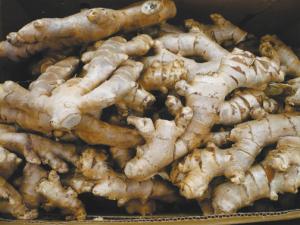Grow your own ginger in a pot or container
Her name was said to be taken from Ginger Rogers and Cary Grant, but plain Jane "Ginger Grant" aboard the SS Minnow. And Gilligan's Island.
"Ginger" is the affectionate term for redheads. The decorative ginger jar with its wide mouth, bulging body and domed lid really was used to store ginger as well as other spices.
Ginger root (Zingiber officinale) of course is used in teas and tonics and the aptly named ginger ale or ginger beer. Ginger is in the same plant family as turmeric (Curcuma longa) so it is equally popular in folk medicine.
Ginger grows from a rhizome, which is a thickened root much like that of the garden iris. This tropical perennial has narrow green leaves and inconspicuous yellow flowers.
You can easily grow your own ginger in a pot or container. Buy organic ginger and soak it in warm water overnight. Use a pot or container with at least one drainage hole. Regular potting soil works fine.
Break the ginger root into large pieces with a few eyes or bumps on each piece. Push the ginger root gently into the soil, covering lightly.
Once your ginger sprouts you can add humidity to the air by misting every few days. Keep the soil moist but not soggy. If the roots stay wet too long they might rot and die.
These bold plants can reach four feet tall, and make great patio plants in the summer.
You can add humidity by placing the ginger on a tray of small stones with water in the tray.
Be sure the bottom of the pot doesn't touch the water. As the water in the tray evaporates it adds moisture to the air, increasing the humidity.Ginger does best in a warm room but with filtered or indirect sunlight. Ginger needs several months of hot and fairly humid conditions for the best yield, but even with less-than-ideal conditions you will get plenty of ginger root.
The longer your ginger plant grows the larger your harvest of ginger root will be.
After you dig up your ginger, save the smaller rhizomes to replant.
Ginger usually has few negative side effects and is on the FDA's "generally recognized as safe" list. It does interact with certain medications, including the anticoagulant drug warfarin and the cardiovascular drug nifedipine. So handle ginger with care, or you may be using that ginger jar for another traditional use, as a cinerary urn, that holds not ginger root but the ashes of the deceased.




















































